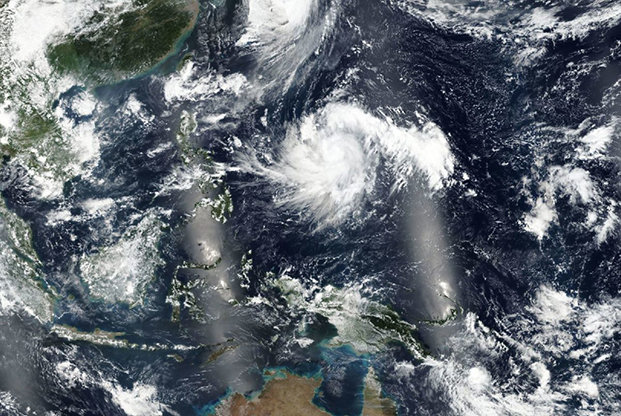
Typhoon Kong-Rey, which is slated to hit Okinawa, is shown in a Sept. 30 satellite image captured by NASA's Earth Observing System Data and Information System (EOSDIS). NASA photo.
OKINAWA, Japan—Less than a week after Okinawa was slammed by the worst typhoon to hit the island since 2012, airmen at Kadena Air Base are preparing for another storm: Typhoon Kong-Rey.
Brig. Gen. Case Cunningham, commander of the 18th Wing, declared Tropical Cyclone Condition of Readiness 1 at 8:44 p.m. local time Wednesday, which means destructive winds of 50 knots or greater per hour were possible within 12 hours.
Earlier Wednesday, he spoke to Air Force Magazine about prepping for storms.
“For us, it is never routine,” Cunningham said. “It’s something that we take very seriously. So it’s about the preparation leading up to the typhoon, to make sure that our families are ready, they’re well informed, that they’ve taken the appropriate measures, and that we have taken the appropriate measures from a mission standpoint.”
Those measures include moving most of the F-15s to hardened, bunker-like structures on the airfield for protection, and may also include evacuating the remaining F-15s and other aircraft to another base in the region. Cunningham said there are “typically somewhere in the neighborhood of 100 aircraft that we’re talking about either moving around or staying here at Kadena.”
In anticipation of Typhoon Trami, which struck the island less than a week ago, the wing evacuated all of the heavy aircraft and about a dozen F-15s to Korea. The location chosen for evacuated aircraft varies based on the storm forecast and the space available at other bases.
The first parts of Trami began hitting Okinawa around noon Sept. 28, with winds from the east increasing to greater than 50 knots by 6:30 p.m. and wailing like a freight train all night. By the morning of Sept. 29, some servicemembers and families on and off base had already lost power, as winds knocked over cars, took down trees, and destroyed trampolines.
The eye of the storm passed over the island on Saturday afternoon, bringing a few hours of quiet and calm before even stronger winds—measured on Kadena at 75 miles per hour—battered the island from the south and west. Many more servicemembers and families lost power, and a combination of high tide and extreme winds flooded roads and wreaked havoc in a water-front off-base neighborhood near Kadena popular with American families.
After a storm, the focus immediately shifts to recovery efforts and getting things back to normal, Cunningham said.
By 6 a.m. Sunday, civil engineers were working to repair downed power lines on base, clear away debris, and restore power to those on-base servicemembers and families who had lost it.
Meanwhile, the storm was churning toward mainland Japan, where it battered Yokota Air Base. Trami damaged powerlines, facilities, military family housing, and brought down more than 40 trees at Yokota, according to an Air Force news release.
Dealing with typhoons is nothing new for the 18th Wing: US forces on Okinawa “live in what we call TCCOR 4, which is, by definition, is be ready to have a typhoon hit within 72 hours” throughout the typhoon season, Cunningham explained.
Still, having two significant back-to-back typhoons is unusual, and brings with it additional challenges. Though Kadena was clear and largely free of debris on Wednesday, some parts of the island were still without power, and crews off base had not been able to remove all the downed tree branches and debris.
The storms and loss of power also caused a run at the commissary: Lines stretched out the door and into the parking lot on Wednesday afternoon.